App Development Cost in 2025: Estimates and Smart Strategies
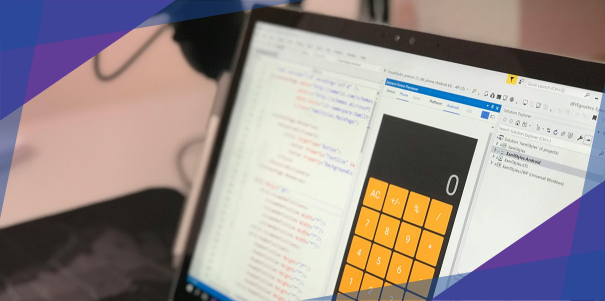
What do buying a car, purchasing a home, and developing an app have in common?
Chances are, you’d like a good price estimate before buying any of these. After all, you would want to get the most out of every hard-earned dollar.
But there is no one-price-fits-all answer to how much app development costs. Custom mobile app development allows any visionary or entrepreneur who has secured enough funding to choose from three major types of apps. Here are some cost estimates:
| $30,000 to $60,000 | For a basic app |
| $60,000 to $300,000+ | For a simple app |
| $300,000+ | For a complex app |
But beyond these numbers lie more critical questions. What makes an app basic? What makes it complex? How can expenses be managed?
If you’re seeking answers to these and other related questions, you have come to the right place.
Read this article to access comprehensive insights and examples to better shed light on app development cost. In particular, I will talk about:
- Factors that influence app development costs (including some tips on raising funding)
- Projected timelines and cost estimates for popular app categories
- App development stages and cost estimates
- How to manage app development cost
- Frequently asked questions
Let’s dive in!
Major Factors That Influence Mobile App Development Costs
Factor 1: App complexity
The type of application you’re creating can heavily influence the app development cost. This is because the more complex the feature, the more time app developers need to study and implement the technology.
Based on the complexity of the features you’d like to implement, your mobile app may fall under the following categories:
Basic apps
A basic app usually comprises 3-4 screens and is published on a single platform, whether on web, iOS, or Android devices. It also often contains mostly static content compared to a simple or complex app.
These types of mobile applications generally have common interfaces and limited features that are relatively easy to implement. Some typical features of simple mobile apps are:
- Signup
- Search
- Basic messaging capabilities
- Profile creation and editing
As these functions are common to most apps, they often require less time for your app developer to implement, minimizing the mobile app development cost.
Estimated Cost to Develop: $30,000 to $60,000
Simple apps
A simple app may comprise more complex features than a basic app. It may also require a custom user interface and data storage, making its development process more time-consuming and, thus, more expensive.
Think of simple apps as basic web or mobile apps that contain more dynamic content, which means more customization. These apps also often leverage existing APIs to offer more value than basic apps.
Mobile apps with extra features, such as the following, are good examples of simple apps:
- In-app purchases
- Push notifications
- Location tracking
- Payment portals
- Social media sharing option
- Geo-location
- Advanced security features, such as biometrics and face ID
Estimated Cost to Develop: $60,000 to $300,000+
Complex apps
A complex app is a web or mobile application that requires more advanced features and high-level user interfaces. They are also typically used across multiple platforms. Having more platforms involves more scenarios, which adds to the complexity. Common examples of complex apps are gaming applications, CRM apps, and other enterprise-level apps.
Some features that may make your web, iOS, or Android app development complex are:
- Online streaming
- In-app audio or video calling
- Novel feature/s
- Any social media-like feature (beyond a sharing option)
- API integration
Estimated Cost to Develop: $300,000 or more
As you can see:
Pro tip: More complex app features = Higher app development costs.
Factor 2: App design
As mentioned earlier, the actual cost of a web or mobile app development project will depend on its size, type, and complexity. From our experience, your needs can change dramatically once a more complete picture of your app idea is formed — its design, functionality, and how it works in the hand.
App ideas tend to evolve during design. Once something comes to life before you, you start to think of alternative ways to improve your app concept. Even if you have an extremely clear vision of what you want, chances are you will change or refine your idea during the design phase.
This is why we advocate for ‘visual scoping via design’ as a better first step than ‘costing via requirements lists.’ We create visual representations of the project first, like sketches or wireframes, so everyone sees what the final product will look like.
With this approach, all parties benefit in the following ways:
- Clearer understanding. Visual designs provide clear and tangible representations of apps. Visual representations are better than a written list of features when it comes to helping you and your developers understand the project better.
- Early feedback. With visual designs, you can give feedback early in the process. This helps ensure that the project aligns with your expectations from the start.
- Identify issues. Visual designs make it easier to spot potential problems or areas for improvement early on. This can save time and resources later in the development process.
- Better communication. Designs help bridge the gap between technical and non-technical stakeholders. Everyone can see the same vision and have a common reference point.
- Accurate cost estimates. Rather than scoping an abstract idea, developers can envision visually what you aspire to build. This allows them to more accurately estimate the time and resources needed to develop your app.
A picture is worth a thousand words. The short video below shows how app designs lend perspective to the overall app development project.
Source: “What you need?” YouTube Channel
As you can see from the video, adding a new element to an app’s design can be as simple as a drag-and-drop motion. But if you’re going to implement that addition into the actual app, developers need time to write new lines of code. The more time they spend coding, the more you have to pay them. This is how changes to the design affect your web, native, or hybrid app development costs.
Though app designs play a crucial role in better estimating how much it costs to make an app, they serve other vital purposes. Design prototypes also improve the chances of acquiring funding. Just look at Good Empire.
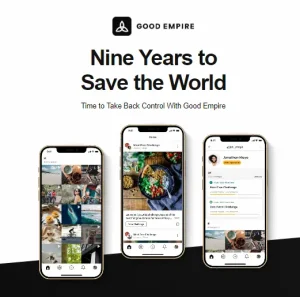
The social challenge app used our design prototype to pitch their idea to investors and on the crowdfunding site Birchal.
The result?
Good Empire got more than 1,000 investors on board and raised over $1.5 million without development.
Read Good Empire’s case study to learn how it has set the benchmark for crowdfunding success across any social platform.
Factor 3: App platform
Your app development cost heavily depends on the type and number of platforms you want to roll out your mobile app on. Based on the platforms they are developed for, apps can be categorized into the following:
| App Type | Key Trait |
|---|---|
| Native app | Functions on either Android or iOS |
| Hybrid app | Works on Android, iOS, and many other operating systems |
| Web app | Runs on multiple operating systems but relies on web browsers and an Internet connection to work |
Native apps
These apps are specifically developed for a particular platform or operating system (OS). They are built using platform-specific programming languages and development tools. Native apps offer the best performance and integration with the device’s features and capabilities. Examples include Instagram for iOS and WhatsApp for the Android OS.
iOS and Android apps are written in different languages. If you are building an app for iOS devices with Appetiser, your mobile app developers will be using Swift. On the other hand, if you’re conducting Android app development, the preferred programming language is Kotlin or Java.
Native app development requires creating separate versions for the Android and iOS platforms. And as you may already guess, that route costs more (refer to the estimated costs table below the discussion on web apps).
Hybrid Apps
Hybrid apps are a combination of native and web apps. They are built using web technologies and then wrapped in a native container that allows them to be distributed and installed like native apps.
Hybrid apps can access some device features through plugins or APIs, providing a balance between native performance and cross-platform compatibility. Examples include the Twitter and Instagram apps built using frameworks like React Native or Flutter.

Source: TechTarget
Web Apps
Web apps are accessed through web browsers and run on multiple platforms without the need for platform-specific development. They are typically built using web technologies such as HTML, CSS, and JavaScript. Web apps are not installed on the device but are accessed via a URL. Examples include online banking apps or web-based email clients like Gmail.
Estimated Cost Estimates per Platform
| App Type | Estimated Costs (Excluding Costs Associated to App Complexity) |
|---|---|
| Native App (Android or iOS) | $8,000 to $14,000 |
| Hybrid App (Android + iOS) | $13,000 to $16,000 |
| Web App | $13,000 to $16,000 |
Source: Couchbase
Factor 4: App developer rates
Developer rates can vary significantly based on several factors, including their geographical location, experience, tech expertise, and skill levels. As of 2024, the average hourly salary of mobile app developers in the US is $51.
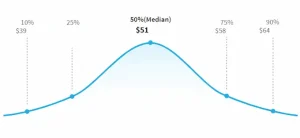
Source: Salary.com
Regardless of the hourly rate developers charge, costs in this bucket will tend to rise if you:
- Hire developers with extensive experience and a proven track record in developing successful apps. Veteran developers often charge higher rates due to their expertise and ability to deliver high-quality results.
- Take too long to develop an app that ultimately doesn’t add up to quality and performance standards
Of course, you can always opt to go cheap by hiring junior developers. But though they offer more competitive rates, they may require more guidance throughout the web or mobile app development process. This need for extensive support can also delay your app development project, consequently increasing the expenses.
Now that you know the factors that impact app development expenses, it’s time to discover relevant estimates for some widely used app categories. The next section will discuss this so you can better understand how to manage your costs when developing the next big app.
Projected timelines and cost estimates for popular app categories
Ever wondered how much it would cost to develop your version of Uber or Tinder?
Regardless of the type of app you want to develop, remember these three letters: MVP.
MVP stands for “minimum viable product.” I will explain later how the MVP concept can help you reduce custom app development cost. But for now, it’s enough to understand that an MVP is basically an app with just the core features to help you lay the foundation for eventual success.
That being said, let’s look at some cost and timeline estimates if you decide to build the world’s next big app.
| App Type | Estimated App Development Cost | Projected App Development Timeline |
|---|---|---|
| Dating app | $147,944 | 6 months |
| Communication app similar to WhatsApp | $154,895 | 6.5 months |
| Ride-hailing app like Uber | $166,437 | 6.75 months |
Sample 1: App Development Estimate for an MVP Dating App
Suppose you want to develop a dating app with basic features plus a video calling feature.
Here’s what your app development timeline may look like if you go with the lean MVP approach:
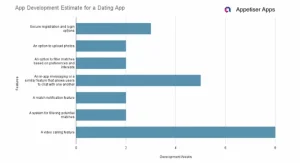
Estimated Total Development Weeks: 24 weeks / 6 months
Estimated Cost: $147,944
Sample 2: App Development Estimate for an MVP App Like WhatsApp
If you opt for the lean MVP approach, here’s what your development timeline and cost would look like:
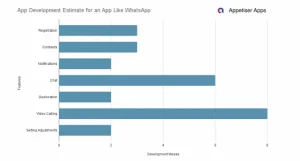
Estimated Total Development Weeks: 26 weeks / 6.5 months
Estimated Cost: $154,895
Sample 3: App Development Estimate for an MVP App Like UBER
If you’re considering developing an app with more complex features and functionalities, such as that of Uber, here’s what your app development timeline and cost may look like:

Estimated Total Development Weeks: 27 weeks / 6.75 months
Estimated Cost: $166,437
Pro tip: As you can see from the samples above, time is of the essence when it comes to app development.
The longer it takes to develop an app = the higher the costs.
Another principle you can infer from the estimates I discussed is this: project delays can adversely affect app development costs. That’s why you need a programmed budget to gain a speed-to-market advantage while ensuring cost-effectiveness. The next section can help you create budgets for every phase of app development.
App development stages and cost estimates
App development can be divided into several stages, each with its associated tasks and expenses.
The following is a breakdown of the typical stages involved in app development and the corresponding cost considerations. For the sake of simplicity, we will use the average cost of app development for basic apps ($45,000) as the basis of cost estimates per development stage.
The table below shows a summary of what I will discuss in this section.
| Stage of the App Development Process | Percent of the App Development Budget | Estimated Expense Based on Basic App Price of $45,000 |
|---|---|---|
| Discovery and planning | 5% to 10% | $2,250 to $4,500 |
| UI/UX design | 10% to 20% | $4,500 to $9,000 |
| Development | 50% to 70% | $22,500 to $31,500 |
| Testing and quality assurance | 10% to 20% | $4,500 to $9,000 |
| Deployment and launch | 5% to 10% | $2,250 to $4,500 |
Stage 1: Discovery and planning
This stage involves identifying project goals, target audience, app features, and defining the overall project scope. Costs can include market research, competitor analysis, user surveys, and the involvement of business analysts or consultants to refine requirements.
Estimated Cost Range: 5% to 10% of the total project cost ($2,250 to $4,500)
Stage 2: UI/UX design
UI/UX design focuses on creating visually appealing and user-friendly interfaces. It includes wireframing, prototyping, creating design assets, and iterating based on feedback. Costs depend heavily on the complexity of the app, the number of screens, custom animations, and branding requirements.
Source: Giulia Lattanzio YouTube Channel
Estimated Cost Range: 10% to 20% of the total project cost ($4,500 to $9,000)
Stage 3: Development
The development stage involves writing code, implementing features, integrating APIs, and building the app’s backend infrastructure. Costs are influenced by numerous factors including the complexity of functionality, the number of platforms (iOS, Android, etc.), development resources’ rates, and any third-party services or tools required (more on these factors below).
Estimated Cost Range: 50% to 70% of the total project cost ($22,500 to $31,500)
Stage 4: Testing and Quality Assurance (QA)
Testing ensures the app functions as intended, has minimal bugs, and provides a smooth user experience. QA costs include manual and automated testing, bug fixing, device compatibility testing, security testing, and performance optimization.
Estimated Cost Range: 10% to 20% of the total project cost ($4,500 to $9,000)
Stage 5: Deployment and Launch
This stage involves preparing the app for release, submitting it to the respective app stores (e.g., Apple’s App Store, Google Play Store), marketing, and ensuring compliance with their guidelines. Costs may include developer account fees, app store optimization, and app store release support.
Estimated Cost Range: 5% to 10% of the total project cost ($2,250 to $4,500)
Stage 6: Post-Launch Maintenance and Updates
Once the app is launched, ongoing maintenance and updates are necessary to address user feedback, fix bugs, and provide new features. Costs can include server hosting fees, bug fixes, performance enhancements, adding new features, and compatibility updates for new OS versions.
Estimated Cost Range: Varies based on app complexity and requirements. Generally, 15% to 25% of the total project cost per year. ($6,750 to $11,250)
🚨 It’s important to note that these cost ranges are approximate and can vary based on various factors. To have a better idea of your app development cost breakdown, take into account the factors discussed above that can impact your app development budget.
How to manage app development cost
1. Choose the right app development partner
Contrary to what some might believe, outsourcing mobile app development is not a waste of time and money, even if you have an extensive technical background.
Though your programming skills may be impeccable, it takes more than writing code to make apps successful in the market. As of writing, the world has around 9 million major apps. Without the right app development partner, making your app stand out from the crowd can be difficult.
To ensure your app development partner will lead you and your app to long-term success, I advise you to follow these tips:
- Seek a partner that provides app business mentorship
- Look for a company with extensive experience
- Ask about their mobile development process and methodology
- Prioritize companies that compete in design competitions and win
- Check for real results
- Assess their technical standards
- Check recruitment processes and developer training and development
Seek a partner that provides app business mentorship
As I mentioned, the app development industry is highly competitive.
That’s why you need to ensure that your app development partner covers both the technical and business sides of app development.
Knowing how to set up and run an app business enables your app to generate enough income for profit and maintenance expenses.
If you’re ready to build your dreams, it can be as easy as booking a free consultation with us. Discover how you can leverage our offerings to write the next chapter of your app development story.
Look for a company with extensive experience
You’re spending top dollar on app development. As such, you’d want to make sure that you find developers who have been in the game for years and actually know what they’re doing.
This is where it’s essential to do your research and make an informed decision. Talk to the developers you are considering and look at their past projects.
Working with a partner who matches your style and philosophies is vital to maximizing your chances of success and creating a smooth experience.
Ask about their mobile development process and methodology
Every good mobile app development team has a streamlined and well-established development process and methodology in place. If the company you’re screening doesn’t have a mobile app development process in place, that’s a red flag. We’d advise staying away from them.
When interviewing an app developer, ask them about their app development process and methodology. You’ll also want to ask them these valuable questions.
As a full-journey app development company, Appetiser follows these steps to ensure our partners a holistic end-to-end experience:
- Ideation
- Sketching
- Ballpark estimates
- Wireframing
- Project scoping and road mapping
- Building and deployment of development team
- Kanban development (code – QA – approve – repeat)
- Growth Planning
- Product launch
- Retainer (optional support and maintenance services)
If you enlist our help in developing your app, you will enjoy a healthy amount of project flexibility. The Kanban development methodology empowers us to seamlessly build your application even if your requirements change midstream. The video below shows how Kanban is effective in adjusting to dynamic project demands.
Source: “Kanban Tool” YouTube Channel
Prioritize companies that compete in design competitions and win
App design competitions serve as platforms for companies to showcase their skills, compete with industry peers, and gain recognition for their outstanding work. These competitions often attract a diverse range of participants, including established design agencies, independent developers, and up-and-coming startups, all vying for coveted titles and accolades.
Additionally, companies that excel in app design competitions often possess a strong portfolio of award-winning apps. This impressive track record serves as a testament to their creativity, attention to detail, and ability to deliver exceptional results.
Focus on unpaid competitions that welcome everyone. Dribbble.com, Behance.com, and Uplabs.com are good starting points for research. They offer a glimpse into the top-performing companies in the app development arena.
Check for real results
We’re talking about results that matter to you.
If your goal is to establish a business worth $100 million, it’s worthwhile to see whether the app developer has previously built a billion-dollar app. If you’re starting from scratch, it’s best to seek out a partner with success stories of apps that went from zero to $1 million.
Similarly, if you aspire to manage a $10 million charity, it’s prudent to verify if a developer has successfully undertaken a $100 million charity project in the past.
It’s always wise to work with professionals with a track record of empowering businesses to reach their desired goals.
At Appetiser, we have a diverse portfolio that includes success stories of all business sizes — from startups to global enterprises — across various industries.
Assess their technical standards
As mentioned earlier, there’s no point in having a highly functional, feature-packed app with a poor design. At the same time, there’s no point in working with a mobile app development company with tremendous design experience yet poor back-end development standards.
So it’s vital to ensure that your app development partner employs excellent front-end professionals and back-end experts. This will help you ensure that the partner you’ll be hiring will handle the end-to-end process rather than outsourcing a certain part of the development process to other app development companies in their network.
In order to uphold project quality, we have implemented the Appetiser’s Gold Standards™.
These standards serve as the criteria for assessing app quality and setting industry benchmarks for both internal and external projects. When you choose to collaborate with us, you have the opportunity to develop your app alongside professionals who certify other developers in the Appetiser Gold Standards™.
Check recruitment processes and developer training and development
A strong recruitment process ensures that the company can identify and attract top-notch developers with the necessary technical and communication proficiencies.
Equally important is the focus on developer training and development. A company that invests in the growth and learning of its developers demonstrates a commitment to maintaining a high level of expertise and staying up to date with the latest industry trends and technologies.
When finding an app development partner, look for indications that they invest seriously in developer professional and personal development.
It is a frequent practice for development companies to send their employees to technical conferences and knowledge-sharing sessions. However, exceptional developers, like Appetiser, take it a step further by establishing our own mentoring programs and technical universities that offer coursework designed to facilitate continuous professional development.
These initiatives equip our developers with new skills and foster a culture of continuous improvement and innovation.
2. Reduce features or come up with a leaner MVP
You don’t necessarily need to add all the features you have planned for your mobile app.
Maybe some of them are not necessary to add in the first place. So, what you can do is cut down the number of unnecessary features. At the same time, we’d advise you to define your minimum viable product (MVP) first.
When developing or designing, start by defining your MVP first. Avoid adding unnecessary features until you have proven that users value your initial vision. If not, then pivot and try to adjust your starting point. Only when your MVP is finding early adoption, or when you confirm your MVP is an actual stepping stone towards achieving your vision, should you look at further expanding the product.
–Michael MacRae Appetiser CEO
By defining your MVP, you can avoid adding any unnecessary features and save a lot of money in the initial stages.
During the initial stage, it’s important to ensure that the features you add solve your target audience’s and the market’s core problems. As you see the results, you can consider further expanding your mobile app.
Source: CrashCourse YouTube Channel
This strategy of going lean with an MVP has enabled us to empower numerous partners to achieve speed-to-market and realize an exponential return on investments. One of which is Dimers.
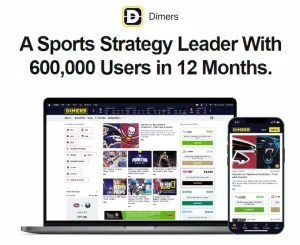
Within three months, Dimers launched and made incredible impacts. The Melbourne-conceived sports prediction web app is storming the North American Market, gaining over 1 million page views and hundreds of thousands of users within 30 days of launch!
Check out Dimers’ case study to learn how this MVP example became one of the industry’s most valuable products.
3. Go from iOS and Android to just one of the platforms
One of the big factors to consider while figuring out the costs of app development is the number of platforms. The more platforms, the higher the costs.
So, in the initial stages, it’s advisable to understand what device your target audience uses the most. Do they love using Android? Or iOS devices?
And based on that, you can develop a native app or launch your app on one platform. After seeing the response, if you think there’s a profitable demand, you can launch it on the second platform at a later stage.
4. Develop a responsive web app instead of a mobile app
This strategy has worked well with MyDeal, one of our existing mobile app clients. The company decided to leverage a web app to create an experience marketplace called Amazed.

Banking on the tremendous success of MyDeal, founder Sean Senvirtne once again collaborated with Appetiser to build a responsive web application that’s set to challenge the biggest brands in the $145 billion experience marketplace industry. You’ll learn more when you read Amazed’s case study.
The beauty of responsive web apps is that they can be used across all devices, from desktop to mobile to tablet. What this means is you don’t have to make one app for every platform, as in the case of native mobile apps. Web apps are also easier to build and maintain because of their relatively simpler components, reducing overall app development cost.
But it is crucial to remember that as your business becomes ripe for scaling, your needs might outgrow the capacity of web apps. In such a case, it might be more cost-effective to upgrade to mobile apps. If you need help identifying what type of application aligns with your market or audience, drop us a line.
5. Avoid hidden app development costs
Most app development estimates account only for the actual design and development phase expenses. However, many other expenses must be factored into the picture. Often, these include:
- Functional costs – fees for third-party integration
- Setup costs
- Launch costs
- App maintenance costs
- Infrastructural costs – CDN, payment for server, etc.
- Management and administrative costs
- App marketing costs
To avoid hidden app development costs, it’s crucial to be diligent and proactive during the planning and development stages. Here are some tips to help you avoid unexpected expenses:
- Scope out requirements. Clearly define and document your app requirements before starting development. This will help you avoid scope creep and unnecessary additions or changes that can lead to extra costs.
- Perform due diligence. Research and choose a reputable app development company or freelance developer with a transparent pricing structure. Look for reviews, portfolios, and testimonials to ensure their track record aligns with your expectations.
- Document. Have well-defined documentation in place that outlines the project scope, deliverables, timeline, and cost structure.
- Adopt an agile development approach. Choose an approach that emphasizes iterative development and regular communication with the development team. This allows for better visibility into the progress and potential cost implications of any changes or modifications.
- Stay involved throughout the development process. Maintain open communication with your development team. Review and test the app at each stage to identify any issues early on. This reduces the chances of costly rework or major revisions later.
Success shrinks cost
You’ve now learned all the critical principles and techniques to estimate and manage app development cost.
Though app development cost can seem unreachable, an app can bring your organization toward heights of success yet unimagined. After all, with the world’s smartphone users projected to increase to around 6 billion by 2029, a mobile app can be that crucial linchpin to exponentially grow your market reach or influence.
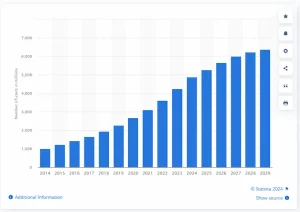
Source: Statista
And with this massive growth, whatever amount you spend on app development becomes worth it as you recoup your investment.
But there’s a catch. You need to get the right app development partner to ensure that your every cent is multiplied into more customers or a larger audience.
And the right partner won’t just build apps for you. They will also build you up and make you a force to be reckoned with in the world of business. We at Appetiser Apps offer that much-needed business mentorship on top of our technical expertise and award-winning product strategies.
Dreaming big doesn’t have to cost a thing. Book a free consultation with us, and let’s start pivoting your strategy toward more impactful results.
Frequently asked questions (FAQs)
What factors influence the cost of app development?
The factors that influence app development cost include the complexity of your app’s features, your knowledge of app design, the platform you’re building your app for, and the rates of your developers.
How can I reduce the cost of app development?
You can reduce app development cost by selecting an experienced and competent app development partner that provides mentorship on top of technical services. Other things you can do to manage app development expenses include developing a minimum viable product instead of a richly-featured app, focusing on one platform before expanding to both Android and iOS, creating a web app first before going for mobile, and being aware of hidden app development costs.
What are the ongoing costs after the app is launched?
After you launch your app, you will have to shoulder recurring expenses to keep it online, accessible, visible, and enjoyable to as many users as possible. Hence, you need to spend on the following, even after you’ve developed and published your app:
- Server or hosting fees (especially if your app depends greatly on the Internet for its functionality)
- App marketing costs
- Fees for third-party integrations or software
- Expenses for updating or fixing your app


